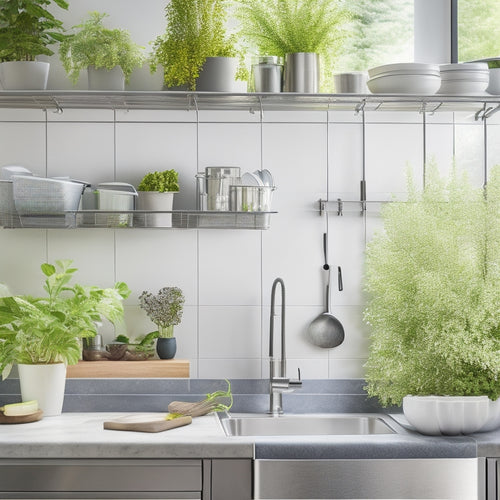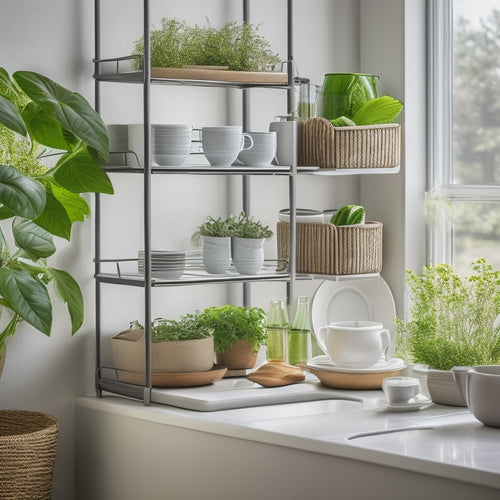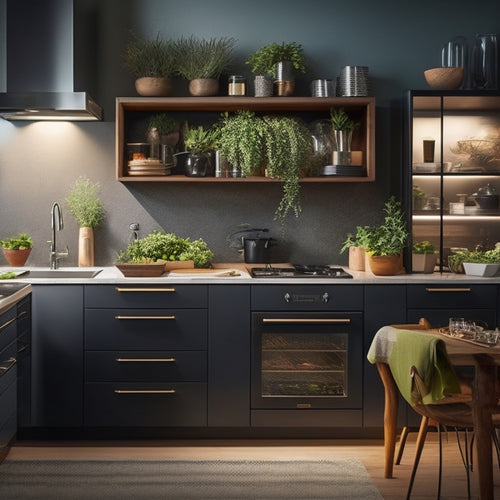
Why Cooking With Kids Doesn't Have to Be Chaos
Share
You can turn cooking with kids into a fun, educational, and bonding experience with a few simple strategies. Start by assigning tasks to your little helpers, preparing ingredients in advance, and using kid-friendly cooking tools. Create a kid-safe zone to minimize risks and simplify recipes for success. By doing so, you'll be able to focus on what really matters - spending quality time with your kids and teaching them valuable skills. And, with a few more tweaks to your approach, you can make cooking with kids a Chaos-Free Zone - discover how to make it happen!
Key Takeaways
• Assign tasks to kids to teach cooking skills, foster teamwork, and promote a sense of responsibility.
• Prepare ingredients in advance to save time, stay organized, and involve kids in meal planning.
• Create a kid-safe zone in the kitchen to ensure safety, comfort, and accessibility.
• Simplify recipes for success by modifying them to be age-appropriate and visual.
• Establish post-cooking cleanup routines and designate cleaning responsibilities based on age and ability.
Assign Tasks to Little Helpers
By dividing cooking tasks into manageable chunks, you can assign specific jobs to your little helpers, making them feel like valuable contributors to the meal-prep process. This not only teaches them essential cooking skills but also fosters teamwork benefits, such as communication and coordination. Assigning tasks also helps to distribute responsibilities, making the cooking process more efficient and enjoyable for everyone involved.
You can start by identifying tasks that are age-appropriate for your child. For example, younger kids can help with simple tasks like washing vegetables or stirring mixes, while older kids can take on more complex tasks like measuring ingredients or mixing batter. As they complete their tasks, be sure to offer guidance and encouragement, helping them build confidence in their abilities.
Prepare Ingredients in Advance
How can you minimize last-minute chaos in the kitchen when cooking with kids?
One simple trick is to prepare ingredients in advance. This time-saving tip can make all the difference in keeping your cooking session with kids stress-free and enjoyable.
Before you start cooking, take some time to chop, slice, or measure out ingredients needed for your kid-friendly recipe. This meal prep step won't only save you time but also help you stay organized in the kitchen.
By having all the ingredients ready, you can focus on guiding your little helpers through the cooking process without worrying about last-minute prep work. Additionally, this step allows you to involve your kids in the process, teaching them about kitchen organization and meal planning.
Use Kid-Friendly Cooking Tools
You'll want to make sure your kids have the right tools for the job, so equip them with kid-friendly cooking utensils that fit their small hands and are easy to maneuver. This will help build their confidence and make cooking together a fun experience. Child-friendly utensils are designed with safety and functionality in mind, making it easier for kids to participate in cooking activities.
Here are some essential kid-friendly cooking tools to take into account:
| Utensil | Description |
|---|---|
| Plastic or silicone spoons | Soft and easy to grip, perfect for mixing and stirring |
| Mini chef's hat | Encourages kids to get into character and take ownership of their cooking |
| Child-sized cutting board | A smaller surface for kids to practice their knife skills safely |
| Silicone spatula | Heat-resistant and easy to maneuver, great for scraping the sides of bowls |
| Kids' kitchen knife | A blunt, safe knife designed for kids to learn basic knife skills |
Create a Kid-Safe Zone
Designate a specific area of your kitchen as a kid-safe zone, where your little chefs can move freely without risking injury or breaking anything valuable. This designated workspace should be clear of hot surfaces, sharp objects, and fragile items that could shatter or break. Take safety precautions by installing safety latches on cabinets and drawers that contain hazardous materials or heavy objects.
Create a comfortable and accessible space where your kids can stand or sit without feeling cramped or overwhelmed. Consider setting up a kid-friendly workstation, such as a low-to-the-ground counter or a sturdy step-stool, allowing them to easily reach and interact with ingredients and cooking tools.
Make sure the area is well-lit and free from any tripping hazards.
Simplify Recipes for Success
Three simple adjustments to your favorite recipes can make all the difference in maintaining your mini-me's engagement and confidence in the kitchen.
By modifying recipes to be age-appropriate, you can guarantee that your little helpers feel empowered to contribute. Here are a few ways to simplify recipes for success:
-
Break down complex steps: Divide intricate tasks into smaller, manageable parts that your kids can handle. This will help them feel a sense of accomplishment as they complete each step.
-
Use kid-friendly ingredients: Swap out exotic spices or hard-to-find ingredients for staples that your kids are familiar with. This will make them feel more comfortable and excited about the cooking process.
-
Make it visual: Use pictures or diagrams to illustrate each step of the recipe. This will help your kids understand the process better and make it more enjoyable.
- Let them take the lead: Encourage your kids to take ownership of certain tasks or even entire recipes. This will nurture cooking creativity and independence in the kitchen.
Make a Mess Containment Plan
As you prepare to cook with kids, anticipate the mess and create a containment plan that saves your sanity and makes cleanup a breeze.
Mess prevention is key, so cover your workspace with newspaper, a tablecloth, or a silicone mat to make cleaning up spills and crumbs a snap.
Designate a specific area for messy tasks, like a 'flour station' for measuring and mixing, to contain the chaos.
Clean up strategies should also be part of your plan. Assign tasks to your little helpers, like washing utensils or wiping down surfaces, to instill a sense of responsibility and teamwork.
Containment solutions like storage bins and caddies can keep ingredients and supplies organized, making it easier to find what you need when you need it.
By embracing organized chaos, you'll be able to focus on the fun of cooking with kids, rather than stressing about the mess.
With a solid containment plan in place, you'll be free to enjoy the experience and create lasting memories with your mini-chefs.
Teach Kitchen Safety Basics
Before allowing your mini-chefs to roam freely in the kitchen, teach them essential safety basics, like handling sharp objects, using oven mitts, and staying away from hot surfaces, to guarantee a worry-free cooking experience. This is vital because kitchen accidents can be devastating, and it's your responsibility as a parent to ensure your child's safety.
Here are some safety rules to instill in your child's mind:
-
Respect the kitchen: Teach your child to move slowly, deliberately, and carefully in the kitchen to avoid accidents.
-
Use utensils wisely: Demonstrate how to hold and use utensils correctly, and supervise them until you're confident they can do it safely.
-
Stay alert: Teach your child to stay focused on the task at hand and avoid distractions like playing with their phone or chatting with friends.
- Follow recipes: Emphasize the importance of following recipes and instructions to avoid mistakes that can lead to accidents.
Incorporate Fun Learning Moments
Now that you've set the stage for a safe cooking environment, it's time to make the experience enjoyable and educational for your kids by incorporating fun learning moments that'll keep them engaged and excited about cooking.
You can create educational activities that teach measurements, fractions, and sequencing, making math and reading comprehension more accessible and enjoyable.
Engage in interactive bonding by letting your kids help with meal planning, grocery shopping, and food preparation. This won't only foster teamwork but also encourage them to take ownership of the cooking process.
Encourage creative exploration by allowing your kids to experiment with new ingredients, flavors, and textures. This hands-on experience will help them develop their problem-solving skills, critical thinking, and creativity.
As you cook together, ask open-ended questions, provide guidance, and offer positive feedback to keep them motivated and confident.
Streamline Cleanup Procedures
To make cooking with kids a sustainable and enjoyable experience, you'll want to establish a simple and efficient cleanup routine that assigns tasks and encourages teamwork. This way, you'll avoid the overwhelming feeling that comes with a messy kitchen and exhausted kids.
Here are some clean up strategies to get you started:
-
Designate a 'cleaning station': Assign a specific area for cleaning supplies, making it easy for kids to access what they need.
-
Make it a game: Set a timer and challenge your kids to clean up as much as they can before it goes off.
-
Teach kids to 'clean as they go': Encourage kids to wipe down surfaces and put away ingredients as they're used.
- Praise their efforts: Acknowledge and appreciate the help your kids provide, even if it's not perfect.
Frequently Asked Questions
How Do I Handle Sibling Rivalry in the Kitchen During Cooking Activities?
When sibling rivalry sparks in the kitchen, you'll manage conflicts by encouraging teamwork and collaboration. Practice active communication, assigning tasks that play to each child's strengths, and celebrate their collective culinary success.
Can I Cook With Kids Who Have Severe Food Allergies or Sensitivities?
"Stepping into the kitchen with kids who have severe food allergies or sensitivities can be a recipe for disaster, but you can whip up a safe haven by using allergy-friendly recipes and clever ingredient substitutions that cater to their needs."
Are There Any Specific Cooking Skills Kids Should Master Before Age 10?
By age 10, you'll want your kids to master basic knife skills, like safely chopping soft veggies, and measuring accuracy, so they can confidently follow recipes and develop a lifelong love for cooking!
How Often Should I Cook With My Kids to Make It a Habit?
"You're probably thinking, 'I'll cook with my kids when I have the time and energy.' But here's the secret: you need to make time, and aim for consistency, setting a regular schedule and boundaries, so cooking together becomes a habit that reinforces their skills and your bond."
Can I Involve Kids in Cooking if I'm Not a Skilled Cook Myself?
You don't have to be a skilled cook to involve kids in cooking; start with basic recipes and assign them simple tasks, like measuring ingredients or mixing, to build their confidence and skills alongside yours.
Related Posts
-

Wall-Mounted Dish Drainer Racks for Kitchens
Wall-mounted dish drainer racks are a game changer for your kitchen. They maximize vertical space, freeing up preciou...
-

Tiered Dish Rack Organizers for Compact Spaces
Tiered dish rack organizers are perfect for compact spaces, maximizing vertical storage while saving precious counter...
-

Smart Kitchen Countertop Storage Innovations
Smart kitchen countertop storage innovations are transformative for maximizing your kitchen's potential. You can clea...


